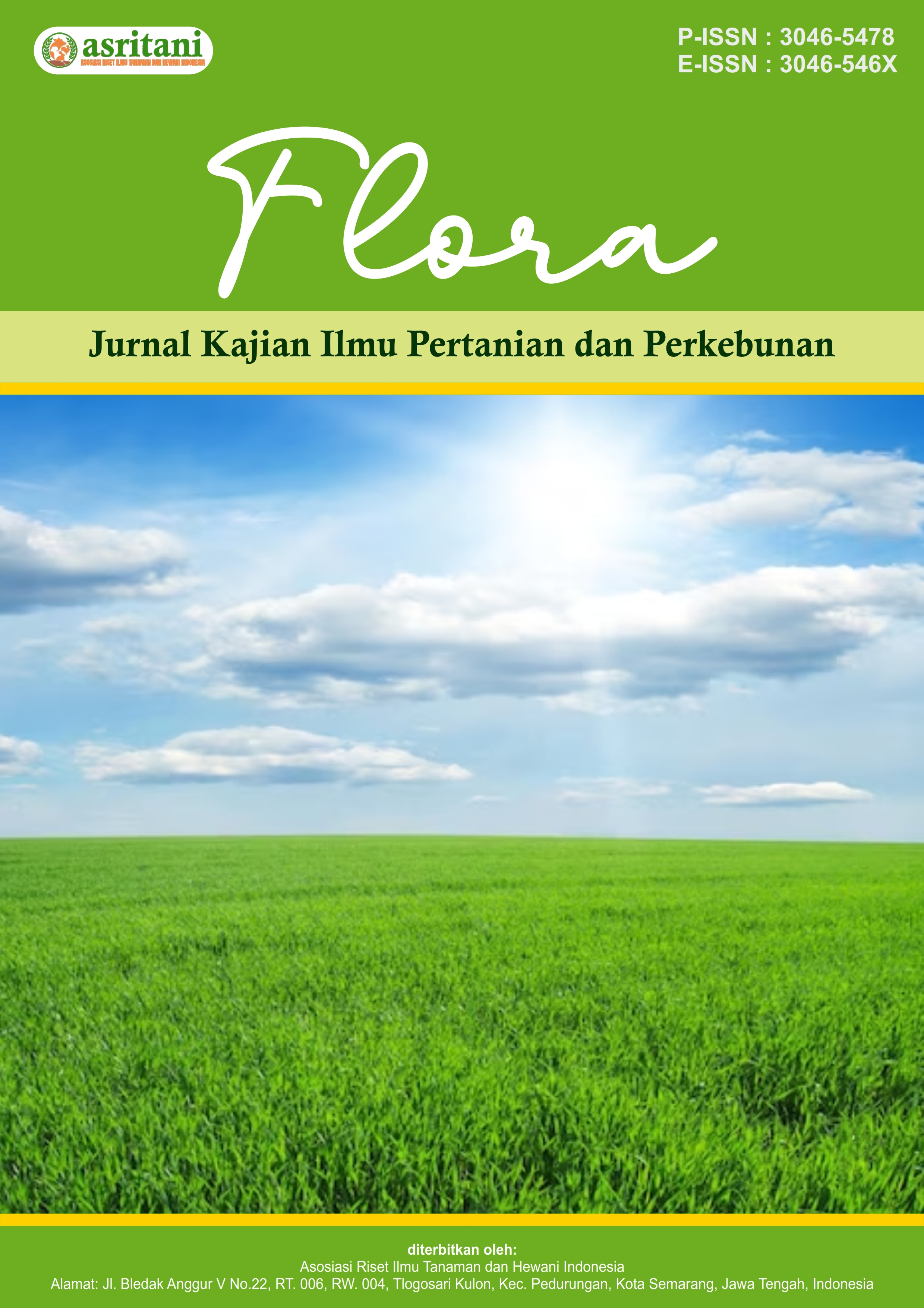Pengaruh Rotasi Tanaman Terhadap Kesuburan Tanah dan Pengendalian Hama
DOI:
https://doi.org/10.62951/flora.v2i1.267Keywords:
rotation, soil, pest control, resource efficiency, sustainable agriculture, biodiversity, soil ecologyAbstract
Crop rotation is one of the most effective agricultural and has significant benefits in improving soil fertility, assessing health and disease, and increasing the efficiency of natural resource utilization. Agricultural strategies that have important benefits in improving soil fertility, assessing health and disease, and increasing the efficiency of natural resource utilization. To maximize nutrient utilization and reduce the risk of certain pests associated with a crop, this practice involves reducing the types of crops grown on the same land in the relevant cycle. To maximize nutrient utilization and reduce the risk of certain pests associated with a crop, this practice involves reducing the types of crops grown on the same land in the relevant cycle. In addition, crop rotation helps improve soil structure, increase cation exchange capacity (CEC), and reduce dependence on chemicals and pests. The study employed a library analysis method by reviewing several previous studies on the impact of crop rotation on agricultural productivity and soil ecology. The results showed that crop rotation can increase nitrogen levels in the soil by up to 20%, reduce pesticide use by up to 50%, and increase air use efficiency, especially in areas with limited air supply. In addition, this practice helps create a more stable agricultural ecosystem by increasing biodiversity, such as reducing the number of natural enemies of pests. The findings of this study indicate that crop rotation is a practice that not only increases crop yields but also strengthens the principle of sustainability. With proper maintenance, crop rotation can be an effective solution to reduce land degradation, improve food security, and improve ecological balance in modern food systems. resilience, and improve ecological balance in modern agricultural systems.
References
Crismono, P. C., & Hudi, S. (2024). Integrasi Nilai Moderasi Beragama dalam Pendidikan Agama Islam untuk Pengelolaan Lahan Pertanian Berkelanjutan. 7, 152–163.
Ezward, C., Indrawanis, E., Nopsagiarti, T., Seprido, S., Wahyudi, W., Haitami, H., Andriani, D., Heriansyah, P., & Marlina, G. (2021). Penyuluhan Budidaya Kacang Tanah Di Desa Kinali Kecamatan Kuantan Mudik Kabupaten Kuantan Singingi. BHAKTI NAGORI (Jurnal Pengabdian Kepada Masyarakat), 1(1), 1–11. https://doi.org/10.36378/bhakti_nagori.v1i1.1163
Fadilla, B., Lizmah, S. F., Afrillah, M., & Ritonga, N. C. (2022). Potensi Pemanfaatan Burung Hantu Tyto Alba sebagai Predator Alami dalam Pengendalian Hama Tikus pada Tanaman Kelapa Sawit (elaeis sp). Jurnal Ilmiah Pertanian, 18(2), 80–86.
Halawa, H. J., Sains, F., Teknologi, D., Nias, U., Sains, F., Teknologi, D., & Nias, U. (2024). Pengaruh rotasi tanaman terhadap kualitas fisik tanah dan efesiensi penggunaan air. 01, 107–112.
Karlina, D., Soedijo, S., & Rosa, H. O. (2022). Biologi Ulat Grayak (Spodoptera frugiperda J. E Smith). Jurnal Proteksi Tanaman Tropika, 5(3), 524–533. https://doi.org/10.20527/jptt.v5i3.1493
Marpaung, P. H., Siburian, F., & Nainggolan, L. P. (2022). ANALISIS YANG MEMPENGARUHI ROTASI TANAMAN ERCIS (Pisum sativum L) KE TANAMAN WORTEL (Daucus carota L) KECAMATAN DOLAT RAYA, KABUPATEN KARO. Jurnal Agroteknosains, 6(1), 81. https://doi.org/10.36764/ja.v6i1.757
NEGARA, I. D. G. J., BUDIANTO, M. B., SUPRIYADI, A., & SAIDAH, H. (2020). Analisis Kebutuhan Air Tanaman Dengan Metode Caoli Pada Tanaman Tomat Dengan Irigasi Tetes Di Lahan Kering Lombok Utara. Ganec Swara, 14(1), 419. https://doi.org/10.35327/gara.v14i1.116
Rahayu, P. (n.d.). Analisis Efektivitas Rotasi Tanaman dalam Mengurangi Ketergantungan pada Pestisida Kimia. 1–7.
Rusmayadi, G., Indriyani, Sutrisno, E., Nugroho, R. J., Prasetyo, C., & Alaydrus, A. Z. A. (2023). Evaluasi Efisiensi Penggunaan Sumber Daya Air dalam Irigasi Pertanian: Studi Kasus di Wilayah Kabupaten Cianjur. Jurnal Geosains West Science, 1(02), 112–118. https://doi.org/10.58812/jgws.v1i02.422
Tolik, M., Afrillah, M., & Alfides, H. (2023). Manajemen Pengendalian Gulma Tanaman Kelapa Sawit (Elaeis guineensis Jacq.) Di PT. ASN Kebun Tanoh Makmue Aceh Barat. Biofarm : Jurnal Ilmiah Pertanian, 19(1), 125. https://doi.org/10.31941/biofarm.v19i1.2530
Downloads
Published
How to Cite
Issue
Section
License
Copyright (c) 2025 Flora : Jurnal Kajian Ilmu Pertanian dan Perkebunan

This work is licensed under a Creative Commons Attribution-ShareAlike 4.0 International License.





